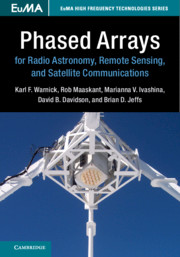Book contents
- Frontmatter
- Contents
- Preface
- Acknowledgements
- Notation and Units
- 1 Phased Arrays for High-sensitivity Receiver Applications
- 2 Active Antenna Receivers
- 3 Antenna Examples
- 4 Transmitting Arrays, Network Analysis, and Pattern Overlap Integrals
- 5 Array Receiver Theory and Modeling
- 6 Figures of Merit for Active Receiving Arrays
- 7 Design and Optimization of Phased Array Antennas
- 8 Numerical Modeling of Phased Array Antennas
- 9 Analog Front End, Array Elements, and Receiver Electronics
- 10 Array Signal Processing, Calibration, and Beamforming
- 11 Interferometric Arrays and Synthesis Imaging
- 12 Real Time Digital Signal Processing
- Index
- References
2 - Active Antenna Receivers
Published online by Cambridge University Press: 14 July 2018
- Frontmatter
- Contents
- Preface
- Acknowledgements
- Notation and Units
- 1 Phased Arrays for High-sensitivity Receiver Applications
- 2 Active Antenna Receivers
- 3 Antenna Examples
- 4 Transmitting Arrays, Network Analysis, and Pattern Overlap Integrals
- 5 Array Receiver Theory and Modeling
- 6 Figures of Merit for Active Receiving Arrays
- 7 Design and Optimization of Phased Array Antennas
- 8 Numerical Modeling of Phased Array Antennas
- 9 Analog Front End, Array Elements, and Receiver Electronics
- 10 Array Signal Processing, Calibration, and Beamforming
- 11 Interferometric Arrays and Synthesis Imaging
- 12 Real Time Digital Signal Processing
- Index
- References
Summary
- Type
- Chapter
- Information
- Publisher: Cambridge University PressPrint publication year: 2018



